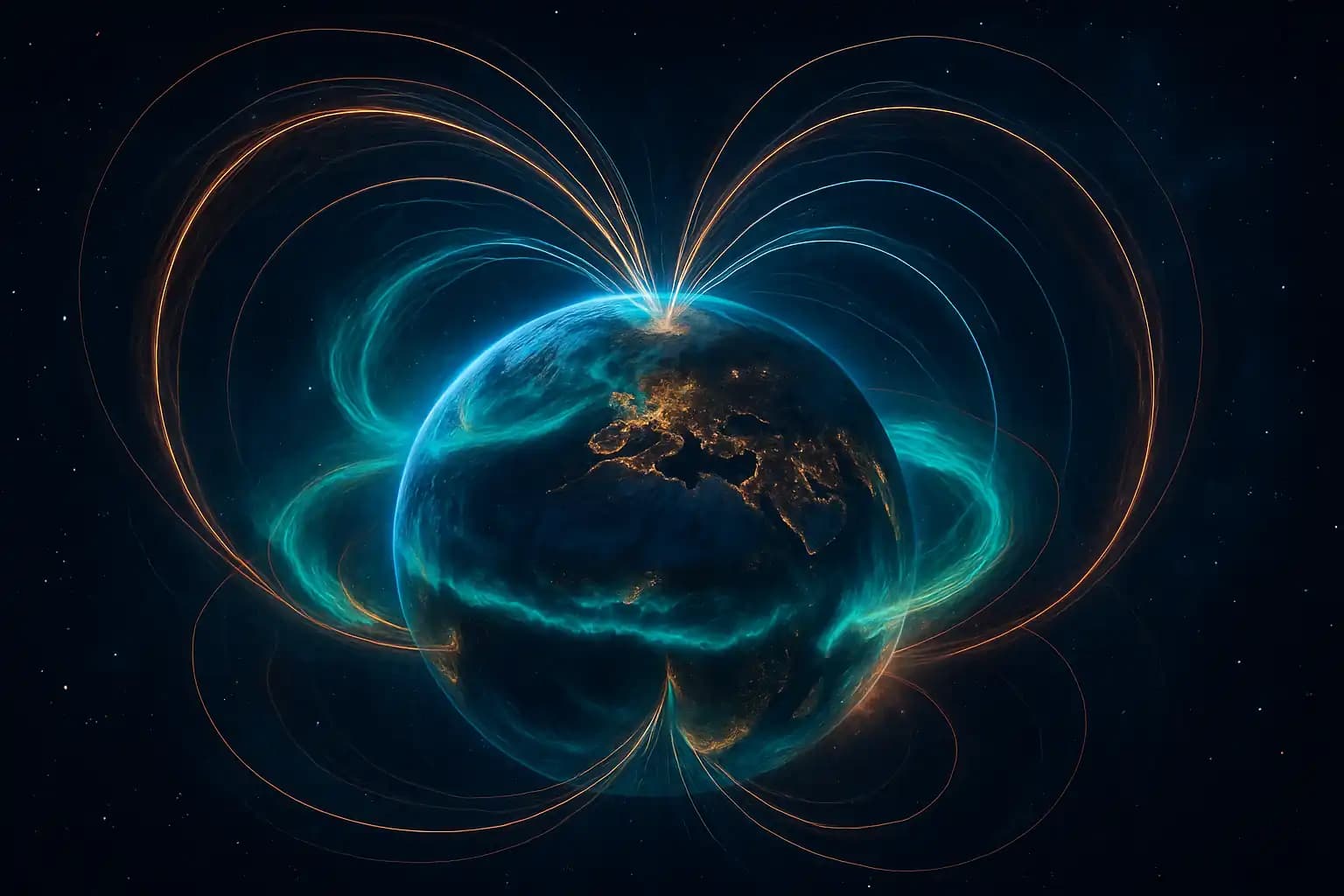The compass has lied before. About 780,000 years ago, north became south and stayed that way for millennia before flipping back. Paleomagnetic rocks prove this, but they can’t predict the next reversal’s impact on a civilization reliant on satellites and superconducting cables. We do know this: Earth’s magnetic field weakens roughly 5% each century, and the poles now sprint instead of stroll. A hyper-connected economy makes a process once relegated to geologic time feel like a looming deadline.
From doomsday clocks to bunker blueprints chronicled in recent investigations, whispers of a magnetic meltdown permeate the internet. Yet beneath the hype lies hard data—satellite maps, power-grid audits, and radiation dosimeters—all flashing amber. A flip may still be centuries away, but the precursors are live now and stressing infrastructure built for calmer skies.
Magnetic Field Drift: Evidence the Shield Is Slipping
Scientists assess the field’s health through Swarm satellites, which detect intensity drops primarily over South America and Antarctica. The leading study on geomagnetic impacts to U.S. grids reports power-line transformers soak up quasi-DC currents when solar wind hits a weakened shield. During the 2003 Halloween storms, a short-lived crack in the field forced operators to shed load across the Midwest. Today the baseline field is 10% weaker, expanding our vulnerability window.
Geophysicists debate timing. The U.S. Geological Survey insists a reversal remains “almost certainly not” imminent, yet the acceleration resembles crustal rumblings seen in planetary-risk briefings. If decay continues, the dipole could collapse to 20% strength before rebuilding in the opposite orientation. That trough—lasting centuries or mere decades—matters more than the flip because radiation rains hardest during that time.
South Atlantic Anomaly: The Dent in Our Magnetic Armor
The South Atlantic Anomaly (SAA) is a growing pothole in Earth’s magnetosphere where cosmic rays dive closest to the surface. NASA teams manually power down the Hubble telescope’s sensors while transiting the region, evidence that the weak spot disrupts hardware. Ground-based consequences are subtle, but the area aligns with outages in low-Earth-orbit satellites that provide everything from weather models to TikTok streams.
In 2020 researchers linked SAA drift to turbulence in the liquid outer core, the same engine that could drive a full reversal. This fuels popular pieces like this anomaly report. While sensational headlines spike clicks, the underlying numbers speak softly and carry a big stick: the anomaly widens 20 kilometers a year. At the current pace, it could span half the Southern Hemisphere by 2050, forcing new satellite constellation designs and insurance models.
Technology on the Edge: Satellites, Navigation, and Power Grids
Earth’s magnetic shell deflects charged particles; weaken it, and satellites suffer. NASA warns that a full reversal could triple surface radiation, endangering astronauts and frying microelectronics. A recent NASA explainer, the top Brave hit on navigation risk, outlines how drifting poles already demand runway renumbering and map updates here. Triple the disturbance, and GPS accuracy could plunge from meters to kilometers, choking logistics from container ships to precision agriculture.
Power engineers worry about another specter: geomagnetically induced currents. During the 1989 Quebec blackout, a midsize solar storm channeled 90-second currents that melted transformer cores. A reversal-era field might let stronger storms penetrate deeper, mirroring the “super-storm” scenario in weather-conspiracy dossiers. The Space Weather Prediction Center ranks worst-case damage at $2 trillion for North America alone—an economic hit surpassing most global recessions.
Biological Fallout: Radiation, Migration, and Human Health
Migratory animals use magnetic cues. A long period of chaotic field lines might reroute whales or derail bird flyways, worsening the ecological crises chronicled in avian-population studies. For humans, the primary risk is radiation, not compass confusion. Without a strong dipole, more solar and galactic charged particles reach aviation altitudes. Crews on polar routes could face annual doses rivaling nuclear-plant limits, forcing airlines to reroute.
Medical researchers examine correlations between geomagnetic activity and cardiac events. Although causal links remain tentative, increased frequency of geomagnetic storms during a reversal might provide data to settle the debate—whether we like it or not. Coupled with a global chip shortage, hospital electronics could face simultaneous stress, echoing vulnerabilities highlighted in AI-risk analyses.
Preparing for the Flip: Hardening Infrastructure and Building Backups
Utilities now install transformer neutral blockers that redirect geomagnetic currents into reservoirs instead of copper windings. SpaceX times Starlink launches to quieter solar windows, learning from a 2022 storm that killed 40 new satellites in one day. Civil planners revisit strategies inspired by underground continuity complexes, but scaled for data centers instead of presidents.
The private sector increases redundancy. Constellations in medium Earth orbit avoid most radiation belts, but they cost more to hard-shield. Ground navigation backup—eLORAN—gains support in Congress because a reversal could jam GPS for months. Semiconductor fabs test radiation-hardened designs to keep pacemakers and military avionics functioning during cosmic flux peaks.
Public outreach may prove the cheapest hedge. Teaching operators to disconnect long-haul lines during solar alerts, staging aviation diversions, and distributing inexpensive radiation monitors build resilience faster than pouring more into steel. Open data hubs like Unexplained.co curate flare forecasts and transformer indices so journalists and town managers can act without waiting for classified bulletins.
Conclusion: The Slow-Motion Crisis Already Underway
Earth won’t capsize; life survived past flips without mass extinction. Yet never before has a magnetic reversal intersected a society rife with delicate electronics. The weakening field and its regional dents preview a test where grid operators, satellite engineers, and public-health planners must pass— or pay. By treating symptoms now—hardening hardware, mapping animal migrations, and rehearsing grid black-starts—humanity can turn a planetary process into a manageable nuisance rather than a systemic shock.
The compass needle’s next mutiny may be centuries away, or it could accelerate tomorrow. Either way, the shield we take for granted is thinning, and the clock is ticking in molten iron beneath our feet.




